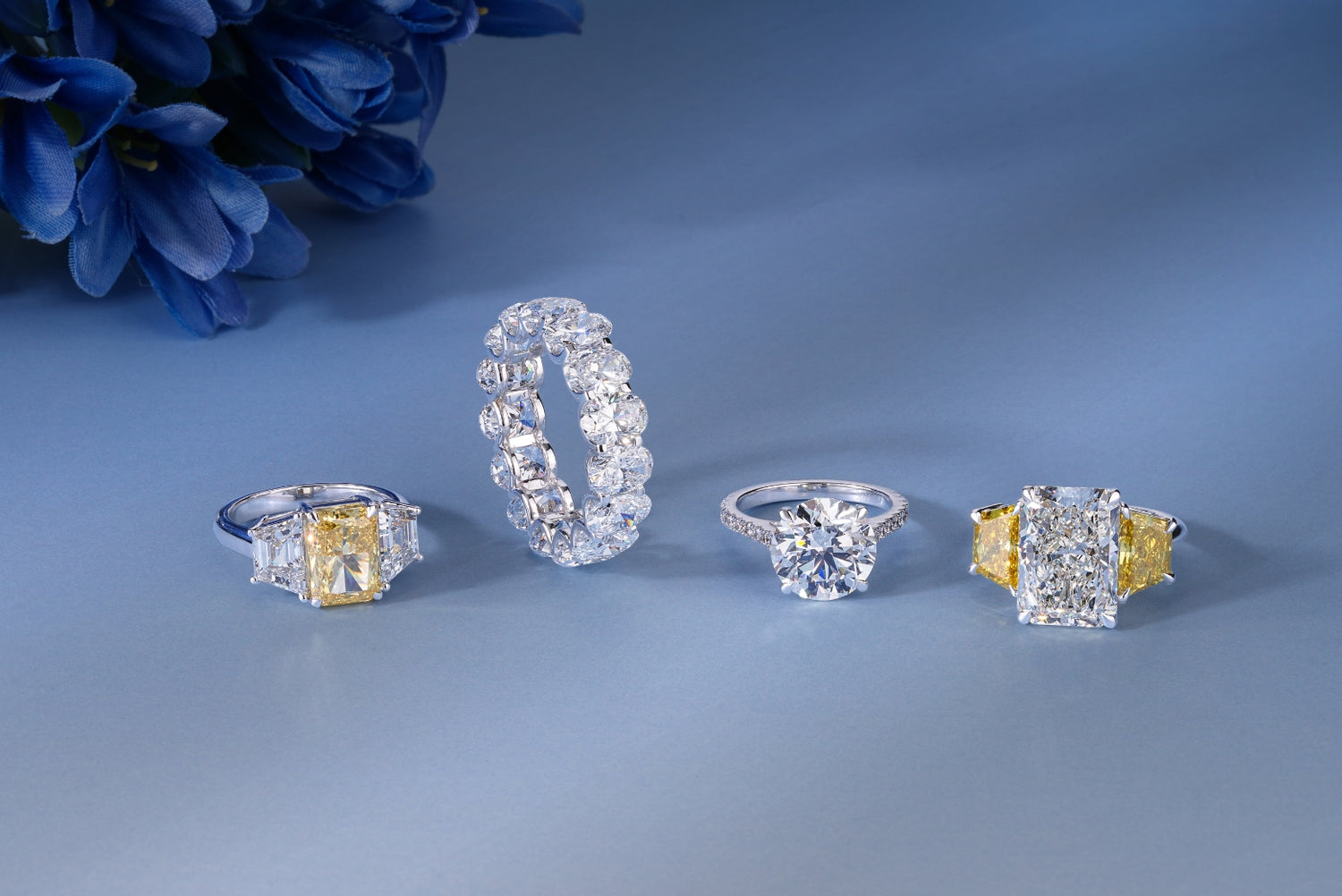Did you ever find yourself falling in love with a ring setting and then asking yourself what kind shape diamond would be best in it? You flip through gorgeous pictures, fantasize about which kinds of stones would fit in those prongs or these bezels, when it dawns on you: perhaps the correct shape of diamond to go with your setting is not so simple as just picking your favourite cut.
The interaction of the shape of the diamond with ring setting dictates how your ring will appear, feel, and behave throughout the years of wearing it on a daily basis. With this kind of pairing correct, a good ring can become the spectacular kind.
Understanding Setting-Shape Relationships
The settings of the rings are designed in a manner that brings out the perfect shapes of the diamond. A round-diamond solitaire setting offers six prongs that are applied in order to hold the stone and allow the maximum amount of light to reach the stone. Test an oval diamond in the same setting and you may consider that the proportions are not right or the stone does not fit in as well.
Consider Pear Jewels Australia's 1.2Ct Round Solitaire Lab-grown Diamond Engagement Ring. The setting is specifically designed to complement the round diamond's circular symmetry, with prong placement that enhances the stone's brilliance while providing secure mounting.
Bezel settings offer different considerations entirely. The 5.0Ct Oval Bezel Diamond Engagement Ring demonstrates how bezel mounting can enhance an oval diamond's sleek profile while providing maximum protection for the stone's pointed ends.
Solitaire Settings: Versatility with Considerations
Solitaire settings are applicable to a wide range of diamond shapes; however, the setting architecture should be in harmony with the nature of the stone. Round diamonds proudly boast of conventional six-prong solitaires that provide the greatest possible entry of light and offer safe mounting.
Oval diamonds require careful prong positioning to protect their vulnerable points while maintaining the stone's elegant silhouette. The 1.25ct Oval Solitaire Lab-grown Diamond Ring shows how proper prong placement can enhance an oval's natural beauty while ensuring long-term security.
Asscher or princess cuts have square shapes and require four-prong settings to fit their corners. The prongs may not fit well on square stones as the prongs will appear to be awkward when placed on the architecture of the stone.
Halo Settings: Amplification and Proportion
Halo settings produce the dramatic visual effect as they encircle the centre stones with smaller diamonds. But the halo shape should be used to complement the centre stone. Round halos are compatible with round centres, forming concentric circles which are natural to touch.
The 2.00CT Round Halo Lab-grown Diamond Engagement Ring exemplifies this perfect pairing. The circular halo enhances the round centre diamond's symmetry while adding substantial visual presence.
Oval centres need long halos which reflect the proportions of the stone. The stone may seem strangely shaped or to be in a bad proportion to the setting, and this is because a round halo is used with an oval centre.
Three-Stone Settings: Balance and Flow
Three-stoned settings require attention to centre and side stones working in collaboration with each other both visually and structurally. The forms need to form appealing proportions and to have safe locations to mount all the three stones.
The Three Stone Round & Pear Lab-grown Diamond Ring demonstrates excellent shape coordination. The round centre provides focal brilliance while pear side stones create graceful transitions that make the entire composition feel unified.
Mixed shapes in three-stone settings require even more careful planning. The 1.5Ct Oval & Pear Three Stone Lab-grown Diamond Engagement Ring shows how similar curved characteristics between ovals and pears create natural harmony despite their different silhouettes.
Vintage-Inspired Settings: Historical Accuracy
Vintage and antique settings tend to be well suited to diamond shapes that were in fashion at the time of their history. The Art Deco settings also commonly feature emerald cuts, asscher cuts or some form of geometric design that represented the architectural influence of the time.
The 1.5ct Elongated Cushion & Marquise Lab-grown Diamond Ring captures vintage glamour through its sophisticated shape combination and geometric arrangement that feels authentically period-appropriate.
Security Considerations for Different Shapes
The shape of the mount is diamond shape which influences the security of mounting. Round diamonds spread the stress equally throughout their periphery and are therefore fairly easy to fix in place. Sharp edges such as marquise, pear or heart shape diamonds need special care to cushion their delicate ends.
The step-cut faceting of emerald and asscher cuts and their rectangular shapes require settings that support their corners allowing light to pass through their broad facets at the table. Bezel settings are especially effective with such cuts since they offer protection at the corners with the geometric look.
Lifestyle Factors in Shape Selection
Your day-to-day activities determine the kind of diamond shape that is effective in your preferred environment. Shapes and settings of active lifestyles are resistant to destruction. Low profile settings (round diamonds) are the most durable thanks to frequent use of their hands.
Pointed shapes are more difficult to handle though they reward you by giving you unique beauty. In the case you love marquise or pear shapes, it is better to have protective lands or adopt different ways of wearing in high risk situations.
Proportional Harmony
The size of the diamond in relation to the setting has a great impact on the appearance. Big diamonds with small settings may seem to be top-heavy, or small diamonds with a big setting may seem to be misplaced or too small.
Take into account the size of fingers when giving proportions. The very same ring can seem huge on small hands when it looked just the right size on longer fingers. On the other hand, designs that are appropriate on smaller hands may not be present on bigger fingers.
Metal Choice Impact
The choice of metals influences the look of diamond shapes in settings. The white metals such as platinum form clean backgrounds through which diamond shapes can be seen clearly and hence they are ideal in displaying unusual cuts.
Diamond appearance can be heated with the use of yellow gold, which is especially compatible with the vintage-inspired shapes and settings. Rose gold is a bit romantic and it blends well with curved lines such as ovals and pears.
Budget Optimisation Strategies
Different diamond shapes offer varying value propositions within identical budgets. Round diamonds typically cost more per carat than fancy shapes, meaning you might afford a larger oval or emerald cut within the same budget as a smaller round.
Take into account the influence of setting choice on the cost in total. Detailed settings are more expensive to produce, but can give smaller centre stones a more solid look. Plain settings gives the emphasis to the diamond alone and more quality stones are needed to create desired effects.
Professional Guidance Benefits
Cooperation with senior jewellers will assist in providing the best shape-setting pairings. The fact that Pear Jewels Australia is highly proficient with the lab-grown diamonds implies that they know how different shapes work in different environments and can lead you to a combination that performs out of this world.
Even professional jewellers can customise the settings to fit a certain proportion of diamonds, a perfect fit and maximum look will be guaranteed, no matter what shape you prefer.
Making Your Final Decision
Choose combinations that resonate with your personal aesthetic while considering practical factors like lifestyle and maintenance requirements. The perfect pairing feels right emotionally while performing well practically.
Remember that trends change but quality craftsmanship endures. Focus on combinations that will remain beautiful and meaningful to you over decades rather than following temporary fashion directions.
Whether you prefer the classic elegance of the 1.2Ct Round Solitaire Lab-grown Diamond Engagement Ring or the distinctive sophistication of mixed-shape designs, the perfect combination exists when diamond shape and setting work together harmoniously to reflect your unique style and values.




